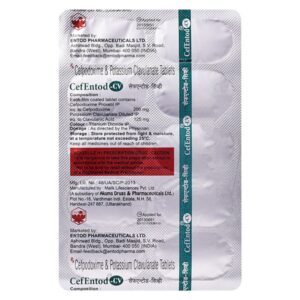CEFPODOXIME + CLAVULANIC ACID
Cefpodoxime: Cefpodoxime is an antibiotic drug that belongs to the class of medications called cephalosporins. It is commonly used to treat a variety of bacterial infections, including respiratory tract infections, skin and soft tissue infections, urinary tract infections, and sexually transmitted diseases.
The mechanism of action of cefpodoxime is by inhibiting the synthesis of bacterial cell walls. It achieves this by binding and inhibiting the activity of the enzymes involved in cell wall synthesis, thus weakening the bacterial cell and leading to cell death.
The usual dose of cefpodoxime varies depending on the type and severity of the infection but typically ranges from 200 to 400 mg taken orally, either once or twice daily. The duration of the treatment may also vary and is usually determined by the prescribing healthcare provider, taking into consideration the specific infection being treated.
As with any medication, cefpodoxime can cause side effects. Common side effects may include diarrhea, nausea, vomiting, stomach pain, headache, and dizziness. Serious side effects are rare but can include severe allergic reactions, difficulty breathing, severe gastrointestinal symptoms, and liver problems. If any severe side effects occur, it is important to seek immediate medical attention.
It is essential to note that cefpodoxime should only be used to treat bacterial infections and is not effective against viral infections such as the common cold or flu. Additionally, it is important to complete the full course of treatment prescribed by the healthcare provider, even if symptoms improve, to ensure the infection is fully cleared.
Clavulanic Acid: Clavulanic acid, a β-lactamase inhibitor, is a drug commonly used in combination with certain antibiotics to enhance their effectiveness. It is primarily used to treat bacterial infections that are resistant to standard antibiotics.
The main mechanism of action for clavulanic acid is its ability to inhibit β-lactamase enzymes. β-lactamase enzymes are produced by certain bacteria and can break down β-lactam antibiotics (such as penicillins and cephalosporins), rendering them ineffective against the bacteria. By inhibiting these enzymes, clavulanic acid allows the antibiotic to remain active and destroy the bacteria.
Clavulanic acid is often combined with amoxicillin to form a drug called amoxicillin-clavulanate (Augmentin). This combination is commonly used to treat respiratory tract infections, skin and soft tissue infections, urinary tract infections, and other bacterial infections.
The dosage of clavulanic acid depends on the specific formulation and the severity of the infection being treated. It is available as an oral tablet or syrup, with different strengths depending on the brand. The dosage prescribed by the healthcare provider should always be followed.
As with any medication, clavulanic acid may cause side effects. Some of the common side effects include diarrhea, stomach upset, nausea, vomiting, rash, and itching. These side effects are generally mild and go away on their own. However, if the side effects persist or worsen, it is important to consult a healthcare provider.
Rarely, clavulanic acid can cause more serious side effects, such as severe allergic reactions (e.g., difficulty breathing, swelling of the face, lips, or tongue) or liver problems (e.g., yellowing of the skin or eyes, dark urine, persistent nausea or vomiting). If any of these symptoms occur, immediate medical attention should be sought.
It is important to note that clavulanic acid should only be taken under the supervision of a healthcare provider and should not be used to treat viral infections such as the common cold or flu. Additionally, it is essential to complete the full course of treatment prescribed by the healthcare provider, even if the symptoms improve, in order to ensure the complete eradication of the infection.





